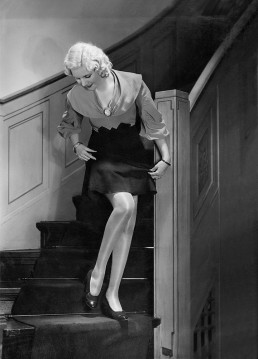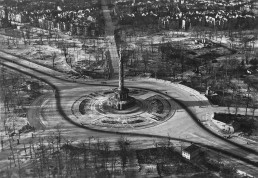The Helmut Newton Foundation celebrates its 20th anniversary in June 2024 with the group show Berlin, Berlin – and simultaneously pays tribute to the city where Newton was born. In the fall of 2003, Helmut Newton established his foundation in Berlin to house parts of his archive, which opened to the public in June 2004 at the historic Landwehrkasino next to Zoologischer Garten station. It was from this very station that Helmut Neustädter, facing constant threat of deportation as a Jew, fled Berlin in early December 1938 – returning 65 years later as the world-famous photographer Helmut Newton. Since then, the Helmut Newton Foundation and the Berlin Art Library have jointly resided in the historic building now known as the Museum of Photography. After the death of June Newton (also known as Alice Springs) in April 2021, the entire collection of works by Helmut Newton and Alice Springs, along with all archival materials, have been housed in the foundation’s archive.
Helmut Newton trained under the legendary photographer Yva in Berlin-Charlottenburg from 1936 to 1938, following in her footsteps to carve his path in the three genres of fashion, portraits, and nudes. After stints in Singapore and Melbourne, Newton’s career took off in Paris in the early 1960s, a period during which he frequently returned to Berlin for fashion shoots in magazines like Constanze, Adam, and Vogue Europe. In this exhibition, we encounter Newton’s models posing at Brandenburg Gate before the 1961 construction of the Berlin Wall. We also see his controversial 1963 fashion series, Mata Hari Spy Story, featuring Brigitte Schilling near the Berlin Wall. In 1979, the newly relaunched German Vogue commissioned Newton to retrace his childhood and youth in West Berlin, visualizing current fashion trends. The result was a multi-page portfolio titled Berlin, Berlin! – which inspired the name of this anniversary exhibition. Newton later shot cover stories in Berlin for Condé Nast Traveler (1987), Zeit magazine (1990), Männer Vogue (1991) and the Süddeutsche Zeitung magazine (2001).
The other exhibition rooms recontextualize Newton’s iconic and lesser-known images of Berlin from the 1930s to the 2000s. From vintage prints by Yva to Barbara Klemm’s political photojournalism, these images span the Golden Twenties into which Newton was born, the devastation of World War II, postwar reconstruction, the rise and fall of the Berlin Wall, into the early 21st century.
Yevgeny Chaldei, a Russian-Ukrainian photographer, immortalized the ground battle around the Reichstag in the final weeks of World War II in the spring of 1945. Meanwhile, Hein Gorny flew over the city the following autumn alongside Adolph C. Byers, documenting Berlin’s postwar devastation through striking aerial photographs. In the late 1950s, the precarious situation in the city slowly stabilized, reflected in the works of photographers Arno Fischer, Will McBride, and F.C. Gundlach, who could still move between the eastern and western parts of the city. However, the erection of the Berlin Wall in August 1961 drastically altered the city’s dynamics once again. 1966 saw the emergence of the student protest movement in West Berlin, documented by photographers like Günter Zint. Meanwhile, an archival work by Arwed Messmer creatively compiles historical photographs from the West Berlin police taken during this same politically charged period. Messmer also brings new life to photographs taken by Fritz Tiedemann, who was tasked by East Berlin authorities in 1949 to systematically document the city, some of which was still in ruins. Tiedemann created panoramas of buildings, squares, and streets by assembling contact prints onto cardboard. Recognizing the value of this unique urban record, Messmer revisited this work, digitally reconstructing and enlarging the panoramas, and producing massive prints for the Berlinische Galerie. Through Messmer’s intervention, we can rediscover Berlin and experience the emptiness that pervaded the city around 1950.
The Berlin Wall emerges as a recurring motif throughout the exhibition. Twelve folios of found photographs by East German border guards, curated and annotated by Arwed Messmer and Annett Gröschner, offer a detailed look at the Wall in the mid-1960s. The Wall resurfaces in other images as well, reflecting the divided city beyond famous sites like the Brandenburg Gate or the Reichstag, collectively capturing the mythos of Berlin and its representation. The exhibition fosters an engaging dialogue between influential projects that shaped photographic and film history: Maria Sewcz’s series inter esse is juxtaposed with Michael Schmidt’s Waffenruhe and film stills from Wim Wenders’ Wings of Desire. Notably, these works all originate from the late 1980s, prior to the fall of the Berlin Wall. The exhibition’s final chapter revolves around the fall of the Berlin Wall and German reunification, featuring photographs capturing these events and their aftermath. This period is represented by Ulrich Wüst’s leporellos capturing a city in transition as well as large-format color photographs by Thomas Florschuetz and Harf Zimmermann, which include interiors of the former Palace of the Republic and intriguing new perspectives of the Berlin TV Tower on Alexanderplatz and the Friedrichswerder Church by Karl Friedrich Schinkel in the city center. They are visual testaments to a city fated “to always become and never be” (Karl Scheffler).
Newton’s portrayal of his hometown, presented through approximately 100 photographs, is complemented, interpreted, and echoed by an equally extensive array of images and approaches from fellow photographers and filmmakers throughout the decades in the adjoining rooms. This juxtaposition, fostering reciprocal references, reflects the curatorial approach adopted by the Helmut Newton Foundation for the 2022 group show Hollywood – another mythical location pivotal to Newton’s visual legacy.
The exhibition is complemented by a TASCHEN publication on Helmut Newton’s Berlin photography
In cooperation with
















